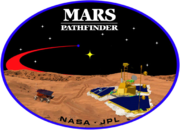
Back سوجورنر Arabic Соуджърнър (марсоход) Bulgarian সোজারনার (বিচরণ যান) Bengali/Bangla Sojourner Catalan Sojourner (Rover) German Sojourner Esperanto Sojourner Estonian Sojourner Rover Basque سوجورنر (مریخ نورد) Persian Sojourner Finnish
 Sojourner rover pictured by Pathfinder lander | |
| Mission type | Mars rover |
|---|---|
| Operator | NASA |
| Website | Official website |
| Mission duration |
|
| Spacecraft properties | |
| Dry mass | 11.5 kilograms (25 lb) |
| Power | Solar panel: 13 W |
| Start of mission | |
| Launch date | December 4, 1996, 06:58:07 UTC |
| Rocket | Delta II 7925 D240 |
| Launch site | Cape Canaveral LC-17B |
| Contractor | McDonnell Douglas |
| Deployed from | Mars Pathfinder |
| Deployment date | July 5, 1997 |
| End of mission | |
| Declared | March 10, 1998 |
| Last contact | September 27, 1997 |
| Mars rover | |
| Landing date | July 4, 1997 16:56:55 UTC |
| Landing site | Ares Vallis, Chryse Planitia 19°7′48″N 33°13′12″W / 19.13000°N 33.22000°W |
| Distance driven | 100 metres (330 ft) |
 Mars Pathfinder mission patch NASA Mars rovers | |
The robotic Sojourner rover reached Mars on July 4, 1997 as part of the Mars Pathfinder mission. Sojourner was operational on Mars for 92 sols (95 Earth days), and was the first wheeled vehicle to operate on an astronomical object other than the Earth or Moon. The landing site was in the Ares Vallis channel in the Chryse Planitia region of the Oxia Palus quadrangle.[1]
The rover was equipped with front and rear cameras, and hardware that was used to conduct several scientific experiments. It was designed for a mission lasting 7 sols, with a possible extension to 30 sols,[2] and was active for 83 sols (85 Earth days). The rover communicated with Earth through the Pathfinder base station, which had its last successful communication session with Earth at 3:23 a.m. PDT on September 27, 1997.[3] The last signal from the rover was received on the morning of October 7, 1997.[4]
Sojourner traveled just over 100 meters (330 ft) by the time communication was lost.[5] Its final confirmed command was to remain stationary until October 5, 1997, (sol 91) and then drive around the lander;[6] there is no indication it was able to do so. The Sojourner mission formally ended on March 10, 1998, after all further options were exhausted.
- ^ Siddiqi, Asif A. (2018). Beyond Earth: A Chronicle of Deep Space Exploration, 1958–2016 (PDF). The NASA history series (second ed.). Washington, DC: NASA History Program Office. p. 195. ISBN 978-1-62683-042-4. LCCN 2017059404. SP2018-4041. Archived (PDF) from the original on 2019-12-08. Retrieved 2019-11-04.
- ^ Cite error: The named reference
faqwas invoked but never defined (see the help page). - ^ "Mars Pathfinder – Mars – Sol 86 Images". mars.nasa.gov. Archived from the original on 2020-10-26. Retrieved 2021-08-15.
- ^ "Mars Pathfinder – Mars – Sol 92 Images". mars.nasa.gov. Archived from the original on 2021-03-22. Retrieved 2021-03-08.
- ^ "Sojourner". Archived from the original on 20 March 2015.
- ^ "Mars Pathfinder – Mars – Sol 89 Images". mars.nasa.gov. Archived from the original on 2020-08-14. Retrieved 2021-08-15.